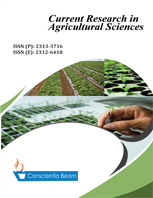Monosex Barb (Osteochilus Hasselti ) Culture with Reduction Feed on Economic Efficiency and Cost Reduction at Net Cage in Cirata Reservoir
DOI:
https://doi.org/10.18488/journal.68/2017.4.1/68.1.7.13Abstract
One of the consequences of intensive floating net cage fish farming is that it needs large amounts of manufactured feeds for the consumption of all the primary freshwater species reared. However, in trophic-level-based fish cultures, the population of fish that feed on plankton, periphyton, and detritus is larger than that of high-trophic-level carnivorous fish. This research aims to discover the ability of barb (Osteochilus hasselti) as a water purifier biological agent in Cirata Reservoir by find the Average daily Gains of the fish, Efficiency and Cost Reduction in production. The experiment ranges from September to November 2014 at Cirata Reservoir’s Floating Net Cage, starting by acknowledging the genus and the number of periphyton from week 1 to week 6. To analyze Growth Rate (GR), a Complete Randomized Design is used by applying five treatments, namely Treatment A: not fed (control), Treatment B: feeding level 1% of the fish’s weight, Treatment C: feeding level 2%, Treatment D: feeding level 3%, and Treatment E: feeding level 4%. The data are then collected in Variant Analysis; if a significant difference is found, it is proceeded to F Duncan Test. The economic parameter are Efficiency and Cost Reduction in production. The results show that there are 20 kinds of periphyton from phytoplankton genus. Twenty types of periphyton of the phytoplankton were of Bacilloriophyceae, Chlorophyceae, and Cyanophiceae classes. As for periphyton of the zooplankton genera, it consisted of Euglenoidea, Rhizopoda, and Rotifer classes. The number of periphyton is not different among the treatments, the GR is not significantly different for every treatment. We found that increased efficiency in the treatment of A (not feed) and decreased production costs as 3 %.

